At a Glance
Summary
The Comprehensive Genome test provided me with a really good range of insights and plenty of tools with which to explore my ancestry. I was happy with the number of matches I had and it was a bonus to get some specific to my Y DNA and mtDNA. I also appreciated being able to contact them and see their family trees for free, though explanations of more complex aspects of the results tables would have helped.
The absence of explanations was a recurring issue that prevented me from taking full advantage of wide range of results and features on offer, but what I did understand was really interesting. The test would therefore be ideal for those interested in getting an in depth look at their ancestry, so long as they’re prepared to take the time to research the results and to work out how to use all the tools available.
Full Review
Family Tree DNA was founded nearly 20 years ago, by Bennett Greenspan, Max Blankfield and Jim Warren, making it one of the longest running and well-known ancestry DNA testing companies around. It initially sold tests that analysed Y DNA and mitochondrial DNA (mtDNA) to report on paternal and maternal ancestry. Since then, the company has added autosomal analysis, allowing customers to find out more about their genetic ethnicity and to find relatives from both sides of the family. In addition, it offers a range of packages, features and projects to give customers a variety of ways to explore their ancestral origins.
The most advanced package on offer, known as the ‘Comprehensive Genome’ includes the ‘Family Finder’ autosomal test, the ‘Y-DNA67’ and ‘mtFull Sequence’ tests.
Product Expectations
It took me a while to find the Comprehensive Genome option on the Family Tree DNA website. There wasn’t a page dedicated to it, though there was one for each of the individual tests it included as well as a brief description of what it would provide on the ‘All Tests’ page. This explained that it was male-specific, as it included the 67 marker Y-DNA test, and also included the Family Finder and full mitochondrial sequence (mtFull Sequence) tests. The results would provide information about the ethnic and geographic origins of my paternal and maternal lines.
Looking at the pages dedicated to the individual tests, I learnt that I’d find out about my haplogroups, as well as my genetic ethnicity, could trace the history of my surname and join free genealogical projects. I’d also be able to connect with living relatives, which I’d be matched with according to all three types of DNA, using “the world’s most comprehensive database”.
Ordering Experience
Clicking to order the Comprehensive Genome test took me to a shopping cart page with all three tests added. I was prompted to input the test participant’s gender and was pleased to see that if I changed it from male to female, the Y-DNA test kit was removed, stating ‘Y-DNA67 was removed from your cart because it is for males only.’. I appreciated that, had I been female, I wouldn’t have been able to accidentally purchase a test that I couldn’t have used (as only males possess Y DNA).
From here I was taken straight to the payment page, where I entered my address and card details (I was able to use Visa, Mastercard, Amex or Discover to pay). I was a bit disappointed to find that shipping was an extra $12.95. However, I was pleased to see that this didn’t increase when I selected the UK as my country, even though Family Tree DNA are based in the US.
I didn’t find anything that struck me as unusual or concerning in the Terms & Conditions and Privacy Policy. It was reassuring to read that Family Tree DNA wouldn’t share any of my identifiable information with third parties without my consent and I was pleased to find out that if they were unable to extract DNA from my sample, I would be provided with another kit.
The kit arrived soon after ordering. I was surprised to find that it was just a plain envelope, rather than a box, which would have been particularly disappointing had it been a gift. Inside, I found swabs and a consent form. As well as asking me to confirm my gender and provide my signature, this requested information about the ethnicities of my most distant known ancestors, for use in an anonymous web database of family ethnic origins.
The samples were easy to take and register, but I was disappointed to find that return postage hadn’t been included in the shipping cost.
A few days later, I was sent an email confirming that my samples had reached the lab. This prompted me to log in to my account and track the progress as they were analysed.
The Results
I was pleasantly surprised to receive further emails, about two weeks later, informing me that my Family Finder and Y-DNA67 results were ready. My mtFull Sequence results weren’t ready for another four weeks, so I was pleased that I was able to explore the others in the meantime.
When I logged into my account, I was shown a dashboard that included Family Finder, Y DNA and mtDNA sections. A ‘myFamilyTree’ builder was also shown, which allowed me to enter information about my known family and add any DNA matches that fitted into it. Its features were well explained through a series of (optional) tutorial steps.
Results Section: Migration and myOrigins Maps
I was most interested in finding out about my genetic ethnicity and ancient geographic origins, so I looked first at the various maps included in the results.
I started with the Family Finder one, which was called ‘myOrigins’ and showed the areas of the world my autosomal DNA was associated with. This, and the accompanying table of results, revealed that 94% of my DNA was European and 4% was Jewish Diaspora. The rest was classified as ‘Trace Results’ and included Scandinavia, South Central Asia and West Middle East. There was a little information box that warned that very small percentages, such as these, could be ‘attributed to background noise’.
Clicking the European result opened a menu that broke it down into ‘British Isles’, ‘West and Central Europe’ and ‘Southeast Europe’. This was a bit less specific than I’d hoped, but I liked that parts of the map were shaded with different colours, showing which countries were included in each of the areas (shown below).
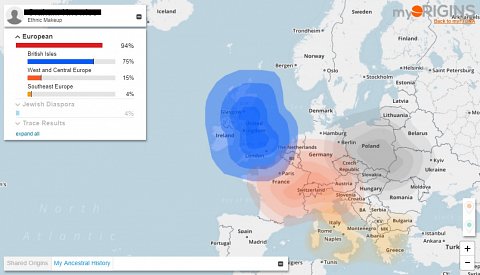
My myOrigins map.
There was also an ‘ancientOrigins’ map that showed information about my earlier ancestors. There were four possible options, each of which I was given a percentage for: ‘Farmer’ (44%), ‘Hunter Gatherer’ (42%), ‘Metal Age-Invader’ (14%) and ‘non-European’ (0%). I was a bit confused by this map and knew I’d find out more about my ancient origins in the Y-DNA and mtDNA sections, so moved on.
My Y DNA and mtDNA results were similar in terms of the features they included. On the dashboard page, I’d already seen that my maternal haplogroup was K1a4a1e and that my paternal one was I-M253, but no further explanation had been included at this point. Luckily, each had an associated ‘Haplogroup Migration Map’ that allowed me to explore the migratory routes of my ancient paternal and maternal ancestors, but also gave me the opportunity to look at those associated with other haplogroups. My maternal map is shown below.
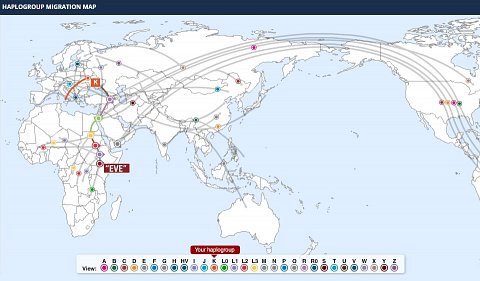
My maternal Haplogroup Migration Map.
Hovering over any of the points on the map provided information about the ancient migratory routes of my ancestors and the haplogroups associated with each one. Each explanation was brief but included enough information to provide a basis for further research, including where the haplogroup originated and spread to.
My Y DNA and mtDNA results sections also included ‘Matches Maps’, which showed where in the world those I’d been ‘matched’ with lived. Having looked at these, I was excited to see more information about my matches, so moved on to these sections next.
Results Section: Matches
I looked first at my Family Finder matches and was impressed to see that I had 1438 in total, which seemed like a lot! I was able to see a range of information about each match, including the date we’d matched, the estimated level of relationship, the amount of autosomal DNA we shared (given in centimorgans (cM)) and their ancestral surnames. A section of the table is shown below.
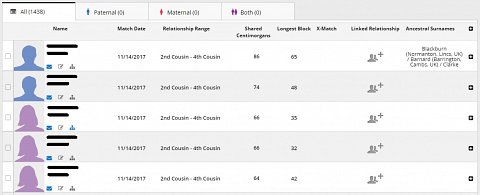
Some of my Family Finder matches.
I could click on my matches to find out more information about them, including their email address, information about their paternal and maternal haplogroups, their earliest known paternal and maternal ancestors, an ‘About me’ section and a list of ancestral surnames.
Unfortunately, in many cases, the email address was all that had been filled in, but I was pleased that this meant I could contact them without having to pay for any kind of subscription.
There was also a tiny family tree icon that I almost missed, but which was really helpful, especially for my closer matches, as I could compare it with my own to see if there was any crossover. I was again impressed that this feature was free, and it was a useful tool for combining my genetic ancestry with more traditional genealogical methods.
The Y DNA Matches page revealed that I had five matches for the 67 markers that had been tested, though I could select to see those that I’d matched with at 37, 25 and 12 markers too. The general layout of the matches was the same as for the Family Finder, but the columns were headed with ‘Genetic Distance’, ‘Name’, ‘Earliest Known Ancestor’, ‘Y-DNA Haplogroup’, ‘Terminal SNP’ and ‘Match Date’ instead.
My mtDNA matches (20 in total) were similar, except without the ‘Terminal SNP’ column and with ‘mtDNA Haplogroup’ rather than ‘Y-DNA Haplogroup’. There were several columns in these tables that I didn’t understand, such as Genetic Distance and Terminal SNP. Unfortunately, I couldn’t find anything explaining these terms.
There seemed to be further information about the locations of my Y DNA and mtDNA matches in sections called ‘Ancestral Origins’, but these included complex looking tables that I couldn’t make sense of and weren’t explained.
My Family Finder results came with a ‘Chromosome Browser’, which I found a lot more user-friendly. I could select up to five matches to visualise the DNA segments we shared, with a different colour used to represent each match (shown below).
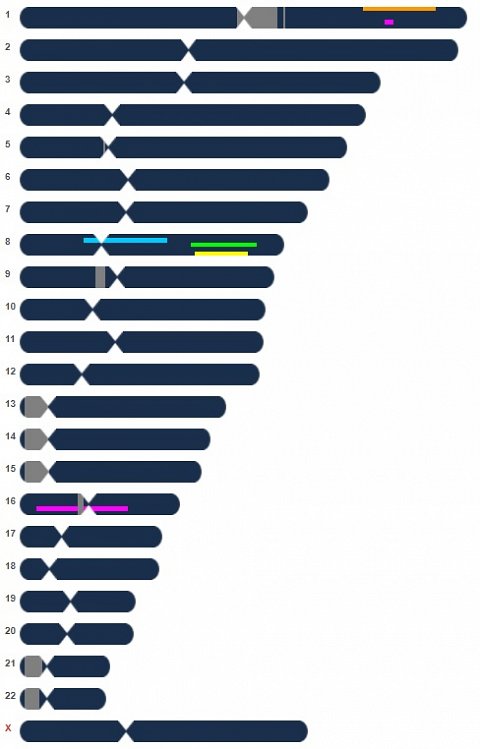
My Chromosome Browser.
I was a bit surprised at how little we seemed to share, but thought it was an excellent way to show how matching worked and to see exactly where my matches and I shared DNA.
Results Section: Other Results
Although the maps and matches made up the majority of the results, there were other sections which provided extra information.
For all types of DNA, I was able to download a copy of my raw data, which was helpful, as I knew I could then upload this to third party providers to get further analyses.
It initially seemed as though a ‘Wellness Report’ had been included with my Family Finder test, as this was featured on the dashboard with the rest of the result sections. However, when I clicked on it, it turned out just to be an advert for a report offered by one of these third-party providers, Vitagene. I felt that it was a bit misleading to include this in the results, as it wasn’t part of the service.
There were several, more obvious, adverts shown on the dashboard page, which I didn’t appreciate, as they were often for things I’d already bought or that weren’t explained at all, for example with the Y DNA SNP package. The Y DNA section also included ‘SNP Map’ and ‘Haplotree & SNP’ sections, which mainly seemed aimed at encouraging me to purchase further testing, but I couldn’t even find an explanation of what an SNP was, so I wasn’t tempted to upgrade.
The Y DNA and mtDNA sections both had ‘Results’ and ‘Print Certificates’ sections, the first of which provided some raw data, sorted into another table and the second of which contained three PDF documents. These were called ‘Understanding Your Results’, ‘mtDNA/Y-DNA Migration Map’ (a more formal version of the one I’d seen earlier) and ‘Y-DNA STR/mtDNA Certificate’ (my Y-DNA certificate is shown below).
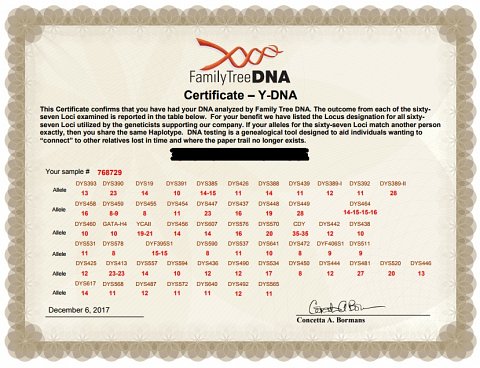
My Y-DNA STR Certificate.
Looking through the Understanding Your Results documents, I was surprised that they hadn’t featured more prominently or earlier on in the results. They went through the basics of the testing, then explained each section in much more detail than I’d found elsewhere and provided links to further resources.
These guides were really helpful when going back through my results and I found I understood the features much better after reading through them. However, there were some things, such as the mention of a blue ‘Help’ button on one of the pages, that I still couldn’t find, even after reading through these documents.
Summary
The Comprehensive Genome test provided me with a really good range of insights and plenty of tools with which to explore my ancestry. I was happy with the number of matches I had and it was a bonus to get some specific to my Y DNA and mtDNA. I also appreciated being able to contact them and see their family trees for free, though explanations of more complex aspects of the results tables would have helped.
The absence of explanations was a recurring issue that prevented me from taking full advantage of wide range of results and features on offer, but what I did understand was really interesting. The test would therefore be ideal for those interested in getting an in depth look at their ancestry, so long as they’re prepared to take the time to research the results and to work out how to use all the tools available.
At a Glance
Summary
The mtFull Sequence test from Family Tree DNA provided a lot of information, some of which was interesting and some of which I found a bit too complex to fully understand. I particularly liked the various maps that were used to display my results, and which simplified a lot of them.
This test provides a lot more detail and features than many other maternal ancestry tests, which I appreciated, even though I struggled to understand it all. For this reason, I would recommend this test to those that are either already familiar with this type of testing, or are happy to do plenty of research around their results to get as much as possible from them.
Full Review
Family Tree DNA is one of the longest running and well-known ancestry DNA testing companies. It was co-founded by Bennett Greenspan, Max Blankfield and Jim Warren in 2000 and first sold tests providing ancestry information based on Y DNA and mitochondrial DNA (mtDNA) analysis. They have since added autosomal testing to their repertoire, in addition to many improvements, packages and extra features to its service.
Along with 23andMe and AncestryDNA, Family Tree DNA are often referred to as one of the ‘Big 3’ ancestry testing providers, but have been faced with an increasing number of competitors over the last few years. The company currently offers two mtDNA tests, the ‘mtDNA Plus’ which looks at part of your mtDNA, and ‘mtFull Sequence’, which, as the name suggests, sequences all of your mtDNA. I decided to try out the second of these tests, which would use my mtDNA sequence to report on my maternal ancestry and match me with living relatives.
Product Expectations
The Family Tree DNA homepage showcased its three main types of testing, autosomal (Family Finder), Y DNA, and mtDNA. I clicked to ‘Learn more’ about the third of these options and was taken to a page dedicated to the mtDNA Plus and mtFull Sequence tests. Both would allow me to trace my direct maternal line, join free genealogical projects and become part of the world’s largest maternal database, which I could use to find matches.
There was also some information about exactly what mtDNA testing was. I learnt that this type of DNA is passed directly from a mother to her children and could therefore be used to trace maternal ancestry, including where maternal ancestors had migrated around the world. Beneath this information there were boxes, containing bullet points about each test, which made them easy to compare. The mtDNA Plus was cheaper but would only analyse part of my mtDNA sequence, whereas the mtFull Sequence (as the name suggested) would provide me with information about all of my mtDNA.
Further information about the differences between the tests was provided in an FAQ section, as well as answers to ‘What is a haplogroup?’, ‘What is mtDNA?’ and other questions I’d had myself and was pleased to find information about.
Ordering Experience
When I added the mtFull Sequence test to my cart a screen came up prompting me to input my gender. I was a bit confused about why this was, as, in the product description I’d just read, it had specifically mentioned that the test could be taken by both males and females. On this page, I was also able to add the name of the person being tested (in this case, me).
Next, I was taken to a page where I could enter my address and payment card details (Visa, Mastercard, Amex or Discover). At this point, I also saw that shipping was an extra $12.95, which seemed a bit high. However, Family Tree DNA are based in the US, so I was pleased to see the cost was the same when I entered my UK address.
Reading through the Terms & Conditions and Purchase Policy I didn’t see anything that concerned me. These stated that Family Tree DNA wouldn’t share my details with any third parties without my explicit consent, which was reassuring. I was also pleased to see that, if there were any problems with my initial sample, I would be sent a replacement kit.
When the kit arrived, I was surprised to find that it was just a plain envelope, rather than a box. This wasn’t a particular problem for me, but I would have found it a bit underwhelming had I bought or received it as a gift. Considering the cost of the test itself, and the postage fee I’d paid, I was surprised by how basic it was.
Inside, there were swabs to take the samples with, containers to store them in, instructions and a welcome letter. A consent form was also included, which, as well as my signature, requested information about the ethnicities of my most distant known ancestors, for use in an anonymous web database of family ethnic origins.
The swabs themselves were easy to use, but I was disappointed to find that the cost of posting them back to the lab hadn’t been covered by the shipping fee. I was happy to find that a return envelope and pre-paid postage had been included, making the shipping fee seem more reasonable.
Soon after I’d sent the samples back, I received an email to confirm that they’d reached the lab, which also provided a login link, allowing me to access my account and track the progress.
The Results
My results were ready around 6 weeks later, which was within the time estimated on the website. The email that informed me they were ready also contained advice on how to access specific features, such as the raw data download option. I logged into my account and was shown a dashboard that displayed the various testing options offered by Family Tree DNA (Family Finder, Y DNA and mtDNA) as well as a family tree builder. The mtDNA part contained seven sections: ‘Matches’, ‘Ancestral Origins’, ‘Matches Maps’, ‘Migration Maps’, ‘Haplogroup Origins’, ‘Results’ and ‘Print Certificates’.
Results Section: Haplogroup and Ancestral Origins
My maternal haplogroup, ‘K1a4a1e’, was displayed on the dashboard page. I wasn’t entirely sure what a haplogroup was, so clicked on the Haplogroup Origins, as this seemed to be the most relevant place to find out more about it. However, when I clicked on it, I found it was a table that seemed to mainly provide information about my matches.
The table was split into four main sections: ‘HVR1 Matches’, ‘HVR1 and HVR2 Matches’, and (under the title ‘HVR1, HVR2 and Coding Region Matches’) ‘Genetic Distance -3’ and ‘Genetic Distance -2’. The first two of these sections were followed by ‘No matches found’, whereas the second two were split into four columns: ‘Haplogroup’, ‘Country’, ‘Comments’ and ‘Match Total’.
All of the haplogroups were the same as mine, which made sense. I guessed that the country was where my matches were from. Only one row contained something in the Comments column, though I had no idea what ‘MDKO: United States’ meant. Some of the ones without any comments in had a ‘-‘ symbol, whereas others were just left blank, but I wasn’t sure why.
Moving on to the Ancestral Origins page, I initially thought it was just a copy of the Haplogroup Origins one, as it used the same table format, with the same four initial sections and ‘No Matches Found’ beneath the first two. However, within the other two sections, I noticed that the headings were different. This time there were five columns, labelled ‘Country’, ‘Match Total’, ‘Country Total’, ‘Percentage’ and ‘Comments’. None of the Comments rows were filled in, and again none of the information was explained.
That said, it was easier to guess the meaning of the information in this table; it seemed to be showing the countries where I had the most matches. They all seemed to be from different places, so, for everywhere but Germany (Ireland, Italy, Canada and England) there was only one match, meaning that the Percentage (of the Country Total) column was a bit useless. I imagine that if I had had more matches though, this could have been quite an interesting feature.
Overall, due to the lack of explanation on these pages, I was left a bit baffled. As I already knew that my haplogroup was associated with the migratory routes of my ancestors, I moved on to Migration Maps, which I hoped might provide me with some information about my haplogroup.
Results Section: Migration Maps
This section included two maps, the main ‘Haplogroup Migration Map’ and a ‘Haplogroup Frequency Map’. I was relieved to find that these were much easier to use and understand than the previous section had been, and provided information about my haplogroups.
The Haplogroup Migration Map allowed me to explore the migratory routes associated with my maternal haplogroup, but also gave me the opportunity to look at others. The map is shown below.

My Haplogroup Migration Map.
I noticed that one of the markers was labelled “EVE”, which I clicked on to find out more. A dialogue box explained that she was the woman that all humans alive today can trace their maternal lineage to. I initially thought that this meant that she was the first woman to have ever lived, but the description made clear that she wasn’t the only woman alive at the time, just the only one who’s lineage has survived to today.
Hovering over any of the dots on the map provided information about the ancient migratory routes of my ancestors and the haplogroups associated with each one. Each explanation was brief, but included enough information to provide a basis for further research, including where the haplogroup originated and spread to. I noticed that ‘U’ wasn’t one of the markers included in my highlighted migratory route. Seeing as I had already read that my haplogroup was a branch of this one, I was a bit surprised and confused by this. Overall though, I thought this map was a great way to visualise what had seemed like quite an abstract concept, making it easy to trace my haplogroup back to “EVE”.
The Haplogroup Frequency Map looked similar, but instead of the routes associated with the haplogroups, it showed pie charts representing which were most common to various areas of the world (shown below).
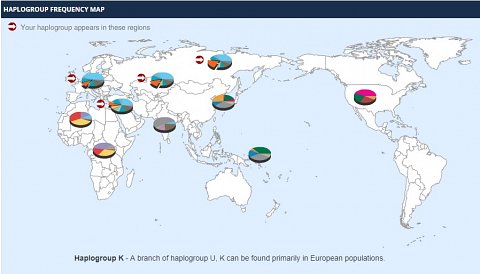
My Haplogroup Frequency Map.
The arrows, indicating the regions that my haplogroup appeared in, made it easy to see that it was common in both Europe and Asia. It was also interesting to see that my haplogroup was not anywhere near being the most common in either continent, as haplogroup H made up the greatest proportion in all of the regions mine appeared in.
Results Section: Matches
Although I’d already seen some details about my matches in the Haplogroup Origins and Ancestral Origins sections, I was excited to see more individual information about them in the Matches section.
I had 20 matches in total, which was more than I had been expecting, based on the previous sections. They were listed in a table (shown below).
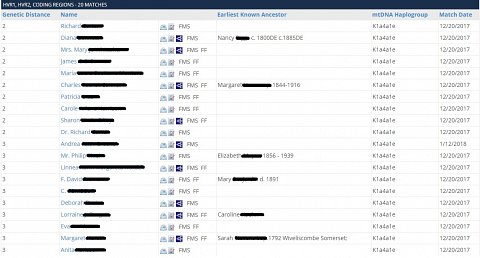
My Matches page (surnames removed).
I was unsurprised to find that we all shared the same haplogroup, and it was interesting to see the earliest known ancestor, though unfortunately I didn’t recognise any names from my own family tree.
Clicking on the name of any of my matches bought up a box that provided information about their maternal and their paternal (if known) haplogroups, their earliest known maternal and paternal ancestors (if known) and known ancestral surnames. There was also an ‘About Me’ section, though I noticed that none of my matches had filled it in.
The first column was labelled ‘Genetic Distance’, which had also been mentioned in the Ancestral Origins and Haplogroup Origins sections. This again wasn’t explained, so I had no further idea of what it meant.
Looking at some of the symbols in the third column, I was also initially confused. However, despite there being no explanation of these either, clicking on them revealed that they could be used to contact my matches, add notes or view their family trees. I wasn’t quite sure what the letters meant, but guessed that ‘FMS’ stood for ‘Full Mitochondrial Sequence’ and ‘FF’ stood for ‘Family Finder’, indicating which tests my matches had taken.
There were several ways in which to search my matches, though it wasn’t hard to look through them myself, so I didn’t really feel the need to use this feature.
Another way in which to view my matches was using the Matches Map (shown below).
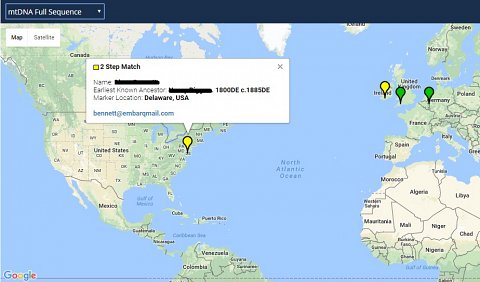
My Matches Map.
When I first opened the section, I was initially confused by a message that stated, “There are no locations available for your matches at this testing level. Please try a different testing level.”. However, I soon realised that the level was set to mtDNA HVR1. When I changed it to mtDNA Full Sequence, the locations of four of my matches were shown. They were located in Ireland, England, Germany and the US. I was a bit disappointed that so few of my matches had chosen to share their location, but appreciated that this wasn’t Family Tree DNA’s fault and was happy to have access to the information I did through this feature.
Results Section: Results and Print Certificates
The final sections I looked at were Results and Print Certificates. The first of these provided some raw data, in two tabs labelled ‘RSRS Values’ and ‘rCRS Values’. I was pleased to see a link to a page explaining them. Whilst these explanations were a little technical, they did provide me with a better understanding of what they were and how they were used to report on my DNA. I learnt that they were both reference sequences which were made up of ancient DNA and that of modern humans. The values attributed to each of them didn’t mean much to me, but I appreciated having the information.
The Print Certificates section contained three downloadable documents: ‘Understanding your results’, ‘mtDNA Certificate’ and ‘mtDNA Migration Map’. The Understanding Your Results guide was very helpful, explaining the concepts backing the results, scientific terms and even some of the results sections that I’d previously been confused by. It didn’t clear everything up, but I came away with a better understanding of my results and several resources with which to further research them. I was just surprised this document hadn’t been more obvious in the results section.
The final two documents showed a more formal version of my Migration Map and also a certificate (shown below), which although not something I would likely print out myself, appreciated the inclusion of.
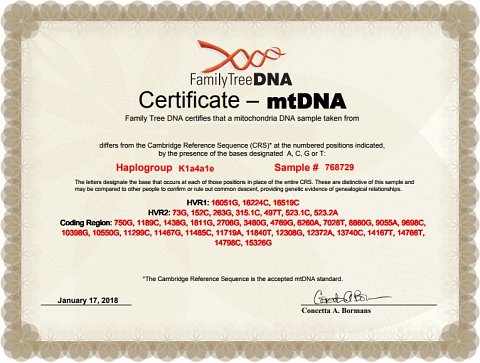
My mtDNA Certificate.
Summary
The mtFull Sequence test from Family Tree DNA provided a lot of information, some of which was interesting and some of which I found a bit too complex to fully understand. I particularly liked the various maps that were used to display my results, and which simplified a lot of them.
This test provides a lot more detail and features than many other maternal ancestry tests, which I appreciated, even though I struggled to understand it all. For this reason, I would recommend this test to those that are either already familiar with this type of testing, or are happy to do plenty of research around their results to get as much as possible from them.
At a Glance
Summary
I enjoyed the Y-DNA67 test - there was a lot of information on offer, and an impressive number of tools with which to dig deep into the details of my paternal ancestry. Having matches exclusive to my Y DNA was also a bonus and I was impressed that this service didn’t involve any extra costs.
That said, I found it difficult to understand several features of these tools and I didn’t feel I got as much from my results as I could have done had I had just a little more guidance. This is definitely a test I’d recommend to those serious about exploring as many aspects of their paternal ancestry as possible, but probably only those willing to invest a significant amount of time researching the results and associated tools.
Full Review
Founded in 2000, Family Tree DNA is one of the longest running and well-known providers of ancestry DNA tests. It was co-founded by Bennett Greenspan, Max Blankfield and Jim Warren and initially sold basic Y DNA and mitochondrial DNA (mtDNA) tests. The company has since added autosomal testing, as well as many extra features, to its service and offers a wide range of tests and packages.
The company is sometimes referred to as one of the ‘Big 3’ ancestry providers, along with 23andMe and AncestryDNA. Although, in the last few years, they’ve been faced with an increasing number of competitors, they remain one of the most popular choices in this category. The company currently offer three Y DNA tests, which are named after the number of genetic markers that are tested: ‘YDNA-37’, ‘YDNA-67’ and ‘YDNA-111’. I decided to try out the 67 marker test, which would analyse my Y DNA to report on my paternal ancestry and match me with living relatives.
Product Expectations
The Family Tree DNA homepage included a link to the Y DNA test page. This provided information about all of the Y DNA tests on offer. I learnt that I’d be able to trace the history of my surname, join free genealogical projects and could use the world’s largest Y DNA database to find living relatives. As I scrolled down the page, I saw images of results and more details about what I’d receive in my report.
There was also a list of FAQs, which explained some of the associated scientific terms, such as what Y DNA was and how they analysed it. These also helpfully explained the differences between their Y DNA tests and helped me to decide which one would suit my requirements.
Ordering Experience
I chose YDNA-67 and added it to my cart, which bought up a screen prompting me to input my gender. I was pleased to see that if I changed it from male to female, it removed the kit from my cart, stating ‘Y-DNA67 was removed from your cart because it is for males only.’, which meant that, had I been female, I wouldn’t have been able to accidentally purchase a test that I couldn’t have used (as I’d previously only males possess Y DNA).
I could then enter my address and payment details. I was a bit disappointed to find that shipping was an extra $12.95. However, I was pleased to see that this didn’t increase when I selected the UK as my country, even though Family Tree DNA are based in the US.
I was able to pay with either Visa, Mastercard, Amex or Discover, after reading through the Terms & Conditions and Purchase (Privacy) Policy. These were pretty straightforward and didn’t seem to contain anything worrying. I was impressed to see that they wouldn’t share my details with any third parties without my explicit consent. It was also good to find out that if they were unable to extract DNA from my sample, I would be provided with another kit.
The kit wasn’t a box, like most others I’ve come across, but a plain envelope, containing the swabs and containers for the samples, instructions, a welcome letter and consent form. The last of these required my signature and requested information about the ethnicities of my most distant known ancestors, for use in an anonymous web database of family ethnic origins. All aspects of the kit were very basic and I think I would have been a bit disappointed had I ordered or received the test as a gift.
The swabs themselves were easy to use, but I was not pleased to find that although a return envelope had been included, the cost of posting it back to the lab hadn’t been covered by the shipping fee.
I was sent an email confirming that my samples had reached the lab. This provided a link I could use to log in to my account and track the progress.
The Results
I was pleasantly surprised when the results arrived around two weeks later, as this was sooner than had been advertised on the website. I was notified via another email, which also contained advice on how to access specific features, such as the raw data download option. Upon logging into the account I’d set up when registering my kit, I was taken to a dashboard that showed all of the different options offered by Family Tree DNA (Family Finder, Y DNA and mtDNA) as well as a family tree builder. Under the Y DNA section, I saw nine options: ‘Matches’, ‘Ancestral Origins’, ‘Haplotree & SNPs’, ‘Matches Maps’, ‘Migration Maps’, ‘SNP Map’, ‘Haplogroup Origins’, ‘Y STR Results’ and ‘Print Results’.
Results Section: Haplogroup
My haplogroup, I-M253, was displayed on the dashboard page. This didn’t mean much to me, as I wasn’t even entirely sure what a haplogroup was, so I clicked on the Haplogroup Origins option to find out more.
The page started with some quick facts about my haplogroup, including that it was 23,000 years old. Apparently, this makes it one of the first haplogroups in Europe, and I found out that it was associated with Northwest, Central, and Eastern areas of the continent. This was interesting, but surprising, as I know my recent ancestors lived in Western Europe.
The rest of the page was made up of a very long table, containing ‘Haplogroup’, ‘Country’, ‘Comments’ and ‘Match Total’ columns. As I scrolled down, I noticed that the table was broken up at points by ‘Genetic Distance’. I didn’t know what this was, and couldn’t find anywhere on the page where it was explained, but I guessed that it had something to do with how related my matches were to me. Overall, I imagine that someone with a better knowledge of haplogroups and genetic matching may have found this page very useful, but I wasn’t able to make much sense of the information myself.
I decided to look at another of the sections, to try and find out a bit more about my haplogroup. I knew that each haplogroup was associated with certain migratory routes, so decided to look at the Migration Maps section next. This consisted of two maps, which were a lot more user-friendly than the previous section had been. The ‘Migration Map’ was interactive, meaning that although the migratory routes associated with my haplogroup were the ones shown initially, I could also explore others. The map is shown below.

My Migration Map, showing the migratory routes associated with my haplogroup.
My Migration Map, showing the migratory routes associated with my haplogroup.I wondered why one of the points was labelled “ADAM”. When I clicked it, I learnt that he was the most recent paternal ancestor common to all humans alive today. It was fascinating to think that we can all trace our ancestry back to one man, even if he lived around 60,000 years ago!
By hovering over different points on the migratory route I could see more information about the haplogroups that had led to mine. This included details about how old they were and what sort of life people around that time might have lived. I thought this map was a great way to visualise what had seemed like quite an abstract concept, making it easy to trace my haplogroup back to “ADAM”.
The section also contained something called a ‘Frequency Map’. This looked similar to the previous one, but instead of displaying migratory routes, showed which haplogroups were most common around the world (shown below).
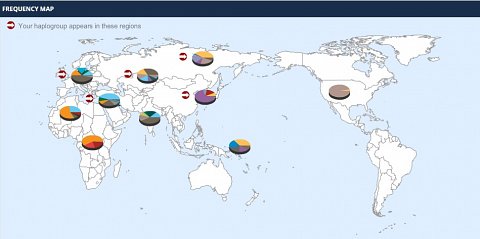
My Frequency Map.
The regions that included my haplogroup were helpfully indicated with an arrow, making it easy to know which ones to look at. It was interesting to see that mine wasn’t the largest in Europe, with Haplogroup R making up 45.43%, but Europe was where it was most common.
Beneath the map, more information about this was provided. I learnt that my haplogroup had likely originated in northern France and spread up to Scandinavia. This was intriguing, especially as I’d recently learnt that I had unexpected trace amounts of Scandinavian autosomal DNA.
Another section associated with my haplogroup was Haplotree & SNPs. This was another page I found quite confusing, as it mainly seemed like an advert for a ‘I1-M253 SNP Pack’. I thought this was a bit sneaky, but have to admit I was intrigued, so clicked to learn more. I read that testing SNPs would determine my haplogroup, which further confused me, as I’d just been learning about mine. However, it then revealed that the more you have tested, the more narrowly you can define your geographic origins and genealogical connections.
Results Section: Matches
Despite the haplogroup sections being a bit of a mixed bag in terms of what I could understand, I was excited to look through my Y DNA matches. I looked first at the section that was just called Matches, and then moved onto the Matches Map. The Matches page revealed that I had five matches for my 67 markers, at between five and seven in terms of Genetic Distance (shown below).
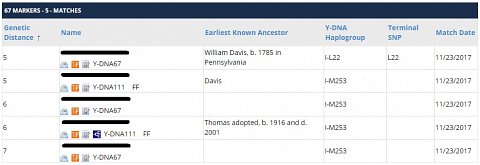
My Matches page (names removed).
Quite a lot of information was provided about each match, including their name, the exact Y DNA test they’d taken, their earliest known ancestor, haplogroup, ‘Terminal SNP’ and the date on which we’d matched.
I was surprised that one of them had a different haplogroup, as I’d assumed that if we matched at enough points on our Y chromosome to be matched as relatives, we’d also be in the same haplogroup. I guessed that maybe this match had had his haplogroup refined by additionally using the SNP package I’d seen earlier, as his was also the only result that included a Terminal SNP.
I was able to change the number of markers I viewed my matches by and noticed that, as the number of markers decreased, the number of matches increased. I wasn’t sure why this was, but was pleased to find that I could easily contact them via email, without having to pay any further subscription fees.
Moving on to the Matches Map, I was happy to find that it was much easier to understand than previous sections. ‘Push Pin’ pointers showed where in the world my matches were located, and it was automatically set to 12 markers (the lowest possible number), so showed the highest number of matches. My map is shown below.
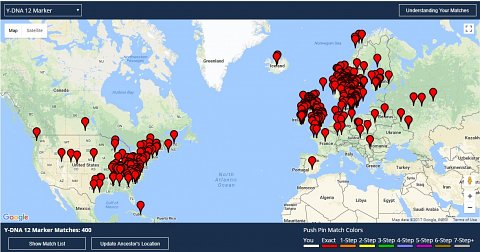
My Matches Map.
All but a few of my matches were located in the US or Europe, which wasn’t a surprise based on what I know about my genetic ethnicity. I was able to click on each pin to see more information about that match, including more specifically where, within that area, they were located and their contact details. It was weird to see that I had three matches in the same area of the city I live in, meaning I could have easily walked past them without realising we share some of the same DNA!
I also noticed that this section included an ‘Understanding Your Matches’ link, which took me to an explanatory page. This included quite a lot of dense text, which I found difficult to take in when first reading through, but after going over it a few times and referring back to my matches, it did help me to better understand them.
Results Section: Y STR Results and Print Results
The final sections I looked at were the Y-STR and printable results sections. The first of these was basically the raw data that had been obtained when analysing my Y DNA. I was able to see the names of all the markers that had been tested, and the associated values. I didn’t fully understand what the values stood for, but I appreciated that this information had been included and was pleased to see that I could also download a copy.
The Print Results section included three PDF documents, entitled ‘Understanding Your Results’, ‘Y-DNA STR Certificate’ and ‘Y-DNA Migration Map’. Looking through the Understanding Your Results document, I was surprised that this hadn’t featured more prominently or earlier on in the results. It went through the basics of the testing, then explained each section in much more detail than I’d found elsewhere, and provided links to further resources. There were also instructions on exactly how to access certain sections of the results.
This was really helpful when going back through my results and helped me to understand and take a lot more meaning from them. However, there were some things, such as the mention of a blue ‘Help’ button on one of the pages, that I still couldn’t find, even after reading through this document.
The other two documents in this section included a map, showing all of the haplogroup migratory paths, and the Y-DNA STR results I’d seen earlier, displayed on a certificate (shown below).
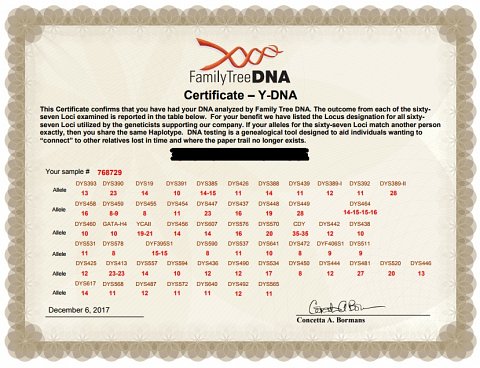
My Y-DNA STR certificate.
I wasn’t sure this was the kind of certificate I would display or necessarily want to show off to my friends, but thought it was nice that this more official version had been included.
Summary
I enjoyed the Y-DNA67 test - there was a lot of information on offer, and an impressive number of tools with which to dig deep into the details of my paternal ancestry. Having matches exclusive to my Y DNA was also a bonus and I was impressed that this service didn’t involve any extra cost.
That said, I found it difficult to understand several features of these tools and I didn’t feel I got as much from my results as I could have done had I had just a little more guidance. This is definitely a test I’d recommend to those serious about exploring as many aspects of their paternal ancestry as possible, but probably only those willing to invest a significant amount of time researching the results and associated tools.
At a Glance
Summary
The Family Finder test provided me with several useful insights and plenty of tools with which to research my ancestry. I was impressed that all of these tools that were included in the cost of the test, giving me the chance to really explore my genetic origins, at numerous levels of complexity.
I was surprised at how broad the myOrigins population clusters were, but still managed to find out about some unknown aspects of my ancestry. I also got loads of matches and it was easy to view their basic information and get in contact with them, though explanations of more complex aspects would have helped.
Overall, I’d say the Family Finder test still offers good value for money, and provides a great range of resources for seasoned genealogists, but wasn't as user-friendly as I'd expected it to be. I'd recommend it to those looking for tools with which to deeply explore their genetic roots, but not to those hoping for fully understand their results without spending time researching the related scientific terms and concepts.
Full Review
Family Tree DNA are one of the longest running and largest providers of ancestry DNA tests. Founded in 2000 by Bennett Greenspan, Max Blankfield and Jim Warren, the company started out by selling basic Y DNA and mitochondrial DNA (mtDNA) tests, but has since developed a wide range of tests and packages.
As well as their DNA tests, they’ve become known for their surname projects that allow people to combine their DNA results with traditional genealogy, to discover more about their paternal heritage. Research done by their team of scientists has also been published in the prestigious scientific journal, Nature, which established a genetic signature of the paternally inherited Jewish priesthood.
I decided to try out their popular ‘Family Finder’ test, which would analyse my autosomal DNA to report on my genetic ethnicity and match me with living relatives.
Product Expectations
The Family Finder test was advertised on the homepage of the Family Tree DNA website, along with the Y DNA and mtDNA options. On the Family Finder page itself, I learnt that I would “discover my ethnic and geographic origins”, “find unknown relatives” and “join the world’s most comprehensive database”. I liked that the information had been condensed into these three summary points, as it gave me an immediate idea of what to expect from the test, before looking at more detail about it.
The rest of the page provided further information about the various features of the test, as well as sample results. I read that in addition to receiving ethnicity information, I would learn about the ancient origins of my ancestors and would find out which ancient European groups my DNA held remnants of.
The test would also be carried out in Family Tree DNA’s own lab, rather than a third-party one and they’d store my sample for up to 25 years at no extra cost. Although this was sold as a bonus, I wasn’t sure I really wanted Family Tree DNA to hold my sample for any longer than they needed to and made a mental note to check whether there were any details of how to opt-out in the terms and conditions.
Ordering Experience
I clicked ‘Order Now’ at the top of the page to add the test to my cart, then was prompted to select my gender and given the option to add my name to the kit. From here I was taken straight to the payment page, where I entered my address and payment details (I was able to use Visa, Mastercard, Amex or Discover to pay). I was a bit disappointed to find that shipping was an extra $12.95. However, I was pleased to see that this didn’t increase when I selected the UK as my country, even though Family Tree DNA are based in the US.
The Terms & Conditions and Privacy Policy didn’t contain anything that seemed unusual and I was pleased to see that they wouldn’t share my details with any third parties without my explicit consent. I was also happy to read that if they were unable to extract DNA from my sample, I would be provided with another. I couldn’t see find any further information about how long they’d store my sample, which I thought was a bit odd, considering they’d mentioned it in the product description.
I was surprised that when the kit arrived it was just an envelope, rather than a box. I would have been quite disappointed if I’d bought or received it as a gift. It contained a consent form, which, as well as asking me to confirm my gender and signature, requested information about the ethnicities of my most distant known ancestors, for use in an anonymous web database of family ethnic origins.
The swabs themselves were easy and quick to use, but I was disappointed to find that return postage hadn’t been included in the shipping cost.
I was sent an email confirming that my samples had reached the lab. This prompted me to log in to my account and track the progress as they were analysed.
The Results
The results were ready almost exactly two weeks later, which was earlier than I was expecting. I received an email notification which provided instructions on how to access different features of the results, for example the raw data download, and pointed me towards resources that would help me to understand them.
I logged in using my kit number and the password I’d received when registering. This took me to a dashboard with sections for Family Finder, mtDNA and Y DNA, as well as one for building a family tree. The Family Finder box contained six options: ‘Matches’, ‘Chromosome Browser’, ‘Linked Relationships’, ‘myOrigins’, ‘ancientOrigins’ and ‘Wellness Report’ (shown below).

My Family Finder Dashboard menu.
I hadn’t expected the results to include any wellness or health information, so clicked on the Wellness Report option to see what this was. It turned out that it was just a page that advertised a service from another company, Vitagene. I thought it was a bit sneaky for them to disguise this as a section of the results, but it was useful to have a suggestion of how I could get more results from my raw data.
Results Section: myOrigins
I was most interested in finding out about my genetic ethnicity, so looked at the myOrigins results first. These revealed that 94% of my DNA was European, 4% Jewish Diaspora. The rest was classified as ‘Trace Results’ and included Scandinavia, South Central Asia and West Middle East. There was a little information box that warned that very small percentages, such as these, could be ‘attributed to background noise’.
I clicked the ‘View myOrigins map’ to see these results in more detail, and was shown a map that highlighted more specifically where my DNA was from. Clicking the European result opened a menu that broke it down into ‘British Isles’, ‘West and Central Europe’ and ‘Southeast Europe’ with areas of the map coloured differently to show exactly which areas these corresponded to (shown below).
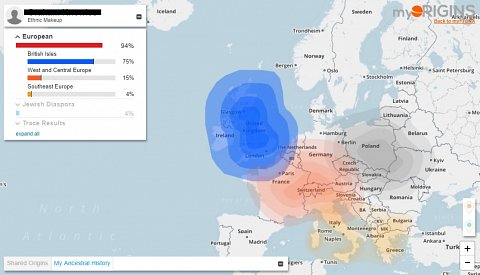
My myOrigins map, showing where in Europe my DNA is from.
Another page showed my full ethnic breakdown in list form, including all of the possible regions, not just those in my DNA. This was useful as, for example, I could see that my Jewish DNA was associated with Ashkenazi, not Sephardic Jewish ancestry. I noticed that some areas had only been split up into large, quite vague categories. For example, the whole of Africa was split into South Central Africa, East Central Africa and West Africa (North Africa had also been included, but in the Middle Eastern section). If this had been where most of my ancestry was, I would have been quite disappointed at the lack of specific detail.
However, there was a link to a useful page that explained the countries included in each ‘Population Cluster’ and a bit about why some of them were quite broad, such as lack of archaeological evidence.
Results Section: ancientOrigins
Next, I looked at my ancientOrigins results, to find out more about my less recent ancestors. There were four possible options, each of which I was given a percentage for: ‘Farmer’ (44%), ‘Hunter Gatherer’ (42%), ‘Metal Age-Invader’ (14%) and ‘non-European’ (0%). As with the myOrigins section, I was able to see these results displayed on a map (shown below).

My ancientOrigins results, shown on a map.
By clicking on each of the results I could see a line showing where these ancestors had likely migrated across the years, with markers highlighting where pieces of evidence had been found, and explanations about which of the categories it was associated with. One example I found really interesting was Ötzi, the Tyrolean Iceman (because his remains were found in the icy mountains of modern day South Tyrol), who was thought to have lived in the Copper Age and was probably part of the Farmer culture.
I found it a bit difficult to match up the information with the percentages I was given for each result type. There also wasn’t any explanation about what the categories actually meant, so I struggled to make any solid conclusions from this section
Results Section: Matches
The next section I looked through was the one that showed me potential living relatives, ‘matched’ with me according to how much DNA we shared. I was impressed to see that I had 1438 in total, which seemed like a lot! I was able to see a range of information about each match, including the date we’d matched, the estimated level of relationship, the amount of autosomal DNA we shared (given in centimorgans (cM)) and ancestral surnames they had in their family tree. A section of the table is shown below.
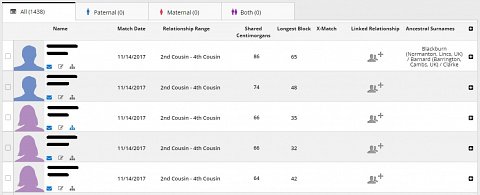
Some of my Matches.
I found out that my matches’ most common surnames were Smith, Miller and Johnson. As these are quite common English surnames I wasn’t sure how much this was to do with my DNA, but it was interesting regardless.
I could find out more about each match by clicking on their row in the table, which bought up a pop-up box. There was also the option to see this information by clicking a little ‘+’ at the end of their row. This provided their email address, information about their paternal and maternal haplogroups, their earliest known paternal and maternal ancestors, an ‘About me’ section and a full list of ancestral surnames.
Unfortunately, for many of my matches, most of this information wasn’t available, but I was pleased to find that all of the ones I looked at had email addresses, meaning I could contact them to find out more. I was also impressed that I could see all of this information and contact them without having to pay for a further subscription on top of the test.
There was a tiny icon that I almost missed, allowing me to view their family tree. This was really helpful, especially for my closer matches, as I could compare it with my own to see if there was any crossover. Again, not all of my matches had made a family tree and some of those that had had opted to keep it private. However, I was again impressed that this was a free feature and thought it would be really useful in combining my genetic ancestry with more traditional genealogical methods.
I noticed that many of my matches had ‘X Match’ in one column of the table. I wasn’t sure what this meant, so went back to the email that had linked to learning resources. I found a helpful section within the ‘Learning Center’ that explained each section of the report. The ‘Matches’ explanation included a list of the terms used, and brief descriptions of what they meant. Several of these were helpful, but, unfortunately, the X Match explanation simply stated that this meant we matched on our X chromosome. As I didn’t really know anything about the X chromosome this didn’t particularly improve my understanding of it.
Results Section: Chromosome Browser
Another feature within the Matches section was the Chromosome Browser. This allowed me to select up to five matches and visualise the DNA segments we shared. I could go directly to this feature from the Dashboard, but found that this was much simpler to use from the Matches section as it easier to sort through my matches, to select which ones to include. I selected five matches and was shown the areas where our DNA was the same, using colours to represent each match (shown below).
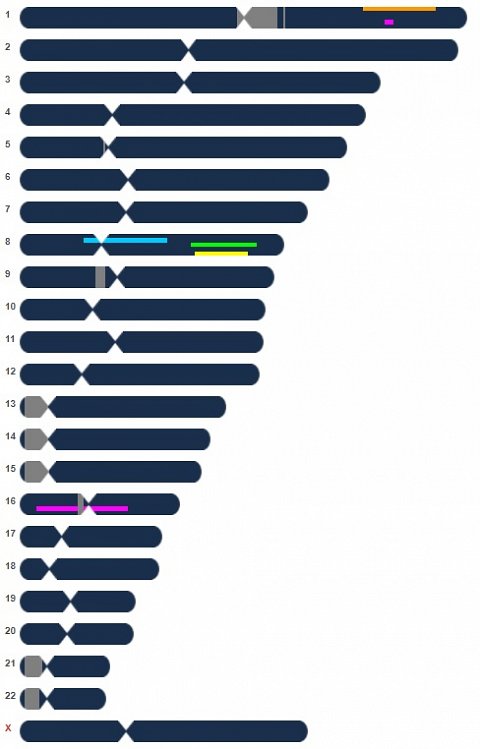
My Chromosome Browser.
This was a great way to see how I was connected to my matches and how our DNA had been used to estimate the relationship between us. I was a bit surprised at how little we seemed to share, but then again, my closest match was estimated to be a 2nd cousin, so I supposed that this made sense.
Summary
The Family Finder test provided me with several useful insights and plenty of tools with which to research my ancestry. I was impressed that all of these tools that were included in the cost of the test, giving me the chance to really explore my genetic origins, at numerous levels of complexity.
I was surprised at how broad the myOrigins population clusters were, but still managed to find out about some unknown aspects of my ancestry. I also got loads of matches and it was easy to view their basic information and get in contact with them, though explanations of more complex aspects would have helped.
Overall, I’d say the Family Finder test still offers good value for money, and provides a great range of resources for seasoned genealogists, but wasn't as user-friendly as I'd expected it to be. I'd recommend it to those looking for tools with which to deeply explore their genetic roots, but not to those hoping for fully understand their results without spending time researching the related scientific terms and concepts.
At a Glance
Summary
In summary I found Family Tree DNA to be one of the most advanced genetic ancestry companies I've tested with. Dozens of tools are available and although the help sections omit certain details at times, this provider is a must for those with a passion for genetic genealogy.
I'd say that Family Tree DNA tests are great value for money, but be prepared to hunt through their online resources to get the most from the results.
Full Review
There were many ancestry tests listed on the Family Tree DNA website, these included: Y-DNA tests for tracing your paternal ancestry, mtDNA tests for tracing your maternal ancestry an autosomal family finder test to help you find your living relatives, and combination packages which allowed you to purchase multiple tests at a discount. For Y-DNA and mtDNA tests you could analyse more markers for an extra fee, and there was even the option to upload genetic data from another company to Family Tree DNA's family finder database
I chose the Y-DNA37 + mtDNAPlus combination test to trace both my paternal and maternal ancestry.
Product Expectations
The website was easy to navigate but it’s a shame the prices were given in US Dollars. The combination package I’d chosen said I’d be able to see the individuals I share my paternal ancestry with up to 340,000 years ago, and those I share my maternal ancestry with up to 18,000 years ago. I was told I’d be provided with my ‘haplogroups’ and that these would indicate the deep ancestral origins of both my paternal line (father's father's father and so on), and my maternal line (mother's mother's mother and so on).
Ordering Experience
When it came to ordering, I had to pay an additional international shipping fee of $12.95. I received the kit after five working days and although it was fairly easy to complete, the release form it contained was a little confusing. I was disappointed to see that return postage to the US wasn’t included and this cost another £3.50. I was sent confirmation that my samples had been received seven working days after returning them.
The Results
I received the full paternal results four weeks later, and the full maternal results three and a half weeks after that. I was prompted to log in to an online account and was shown lots of different areas to explore.
Results Section: Paternal Haplogroup
My paternal haplogroup was predicted to be ‘R-M269’ and upon entering this section (shown below), there was a brief description of where my paternal ancestors have migrated from. I found this information a little confusing and it wasn’t yet clear to me what a haplogroup was. My ‘haplotree’ was below the description and showed all the other paternal haplogroups in relation to mine. I had the option to 'Add' (buy) SNPs, but I wasn't sure why I would.
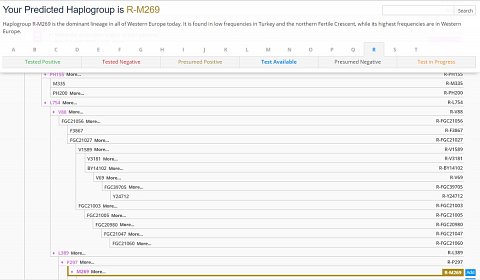
The location of my predicted haplogroup on the Y-DNA haplotree.
An interactive migration map was available that showed my paternal ancestors had migrated from Africa into Southwest Asia, and then into Europe. I was also invited to choose my own 'SNP' but I wasn’t sure what an SNP was or why I would choose one. My raw Y-DNA37 marker data was provided in another section.
Results Section: Maternal Haplogroup
My maternal haplogroup was shown to be ‘H’ and upon entering this section, I was given a short description of where my maternal ancestors have migrated from. A map was provided that showed the migratory paths of all the maternal haplogroups (shown below), and I learned that haplogroup H originated between 33,000 and 26,000 years ago from Africa. My group had then migrated into Southwest Asia before moving into Europe and across to Northern Spain.

The maternal haplogroup migration map.
The frequency map showed pie charts over each region that my haplogroup was prominent in, and how frequently they were found there, explaining below a bit about how my maternal haplogroup, H, migrated across Europe after the last ice age.
Results Section: Paternal and Maternal Matches
These sections showed the individuals who I share my paternal and maternal ancestry with - providing they were on the Family Tree DNA database - aka my ‘matches’. For my paternal line I was shown to have no matches for a Y-DNA37 marker comparison, but two matches for a Y-DNA25 marker comparison, and 624 for Y-DNA 12 (shown below). Contact details for my matches had been provided and I could see that an ancestor I shared with one gentleman was born in County Waterford, Ireland, in 1792 – I found this fascinating!

My Y-DNA matches at 25 markers.
For my maternal line I was shown to have 400 ‘HVR1’ and 235 ‘HVR2’ matches (HVR1 and HVR2 indicating different regions of the mtDNA that was analysed), and it was interesting to see that I shared a maternal ancestor with many of them.
Results Section: Ancestral and Haplogroup Origins
There were also sections on my paternal and maternal ‘Ancestral Origins’ and ‘Haplogroup Origins’. These showed which countries my matches were in (my maternal matches map according to the HVR2 region of my mtDNA is shown below) and where other members of my haplogroups were located. This information was displayed in map and table format.
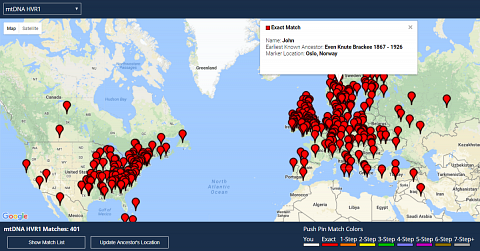
My mtDNA HVR1 matches map.
For my paternal ancestry, one of the tables (shown below) showed that at ‘genetic distance -1’, 3% of my paternal matches lived in England, 5% in Wales, and 4% in France! I wasn't aware of any Welsh or French relatives on my father's side of the family.
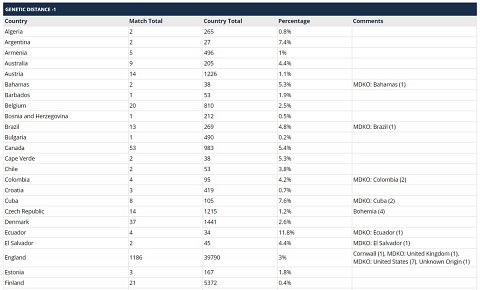
My paternal ancestral origins matches at genetic distance -1.
It’s a shame there wasn’t an explanation of what genetic distance was or this would have been more meaningful to me. I was interested to see that at HVR1 level in the maternal section, 2.1% of my matches lived in England, 2.3% in Germany, and 3.5% in Greece! This was surprising as I was expecting my mother's side of the family to have the most matches in England, and don't believe we have any Greek relations.
I was invited to try the new ‘myFamilyTree’ feature, which would allow me to charter my current family tree and connect to anyone else the Family Tree DNA network had matched me with. The prospect of growing my family tree was an exciting one, and this tool made it much easier to see how my matches connected to my existing family.
Summary
In summary I found Family Tree DNA to be one of the most advanced genetic ancestry companies I've tested with. Dozens of tools are available and although the help sections omit certain details at times, this provider is a must for those with a passion for genetic genealogy.
I'd say that Family Tree DNA tests are great value for money, but be prepared to hunt through their online resources to get the most from the results.
Visit Family Tree DNA to learn more about this DNA testing service >


